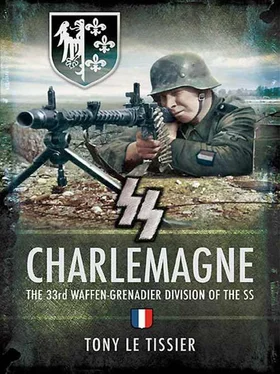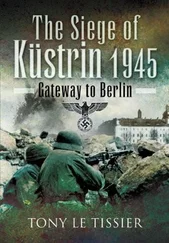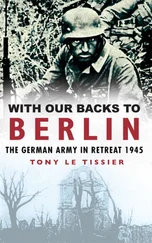But the enemy had more success in the 2nd/57th’s sector, breaking all contact between the 1st/58th and the 2nd/57th. The Soviets occupied Bärenwalde and infiltrated the rear of the 1st/58th, obliging Captain Monneuse to withdraw in turn. Being delayed, he ordered Lieutenant Géromini’s 2nd Company to open a passage and then provide a rearguard for the battalion’s withdrawal.
The 2nd Company’s attack proved irresistible and all the heavy weapons got through without incident except for two 75mm guns, the carriages of which had been damaged and were made unserviceable. All the wounded were carried out on the men’s backs to the new position along the railway line.
It was almost noon when the vanguard of the 1st/57th came into sight of Bärenwalde and found that the village was already occupied by Russian tanks. The 1st/57th then made a half turn to resume contact with the 1st/58th, but some members of that battalion encountered on the way said that there had just been another Russian attack, more violent than before and supported by flame-throwers, which had completely disorganised the defence.
With the Russians occupying Bärenwalde and advancing along the Heinrichswalde road to Hammerstein, Fenet’s 1st/57th was in danger of being encircled. To avoid this, the battalion marched westwards under cover of the woods that occupied a large part of the terrain between Bärenwalde and Hammerstein, and arrived at the camp at nightfall having sustained another two attacks on the way.
Second-Lieutenant Rigeade’s 3rd Company of the 1st/58th had occupied the position designated, well away from the remainder of the battalion, at night and without prior reconnaissance, in liaison with the 15th SS-Latvian Division. The first Russian attack occurred at 0900 hours on the 25th. The Latvians dug in on the right were soon located by the enemy and, coming under heavy mortar fire, quickly withdrew. Believing that they had swept aside all resistance, the Russian infantry continued to advance but had to retire rapidly when they came under surprise fire from the well-camouflaged 3rd Company.
Then elements of the 1st/57th passed by, coming from the south as they withdrew towards Bärenwalde. Now isolated without contact to either left or right, Second-Lieutenant Rigeade was withdrawing his company on the road to Bärenwalde when two tanks with infantry escorts emerged from the woods on his right. The latter were engaged with automatic fire and one tank was damaged by a Panzerfaust , but the company was split into three groups, which then made their way through the woods to reach Bärenhütte.
The withdrawal of the 2nd/57th was covered by the infantry guns of the regimental company and the heavy weapons of Second-Lieutenant Philippe Colnion’s 8th Company deployed alongside the railway line, as well as a combat team from Second-Lieutenant Brunet’s 6th Company. The remains of the 2nd/57th, in some disarray, had to regroup behind the railway line to the left of Bärenwalde station, which served as the rough boundary with the 1st/58th, of which there was still no news, and the first elements of which had yet to withdraw.
Towards midday on 25 February, as Brigadier Puaud and SS-Colonel Zimmermann watched from the front line, the Russians launched a new attack. Despite the incredible ravage caused to this human tide, the wave of attackers advanced steadily and some twenty tanks emerged from Bärenwalde with the support of ground-assault aircraft. The 6th Company of the 2nd/57th, which had not yet completed its withdrawal, put up a magnificent defence, and was able to break contact thanks to the very heavy and precise fire from Captain Robert Roy’s infantry gun company, which stopped the enemy and allowed the withdrawal to take place.
A total of four enemy tanks were destroyed. The first by an NCO using a Panzerfaust , the second by a mine placed by the regiment’s engineer section, the two others by the regimental 75mm anti-tank guns that were old training pieces towed into position by a tractor taken from the Latvians. However, these guns were soon silenced and rendered useless. Officer-Cadet Vincenot, who was directing their fire, was seriously injured as a result of this violent enemy fire, and Lieutenant Flacy was wounded by a tank shell.
But the enemy started gaining ground and losses were heavy. The position became untenable and, after an hour of fighting, Captain de Bourmont was obliged to give the order to withdraw at the very moment that the first elements of the 1st/58th pulled back on the right wing.
The 2nd/57th was the first to set off to the north towards Elsenau, but its 7th and 8th Companies remained isolated north of the road and railway. Cut off, they retired fighting all the way to Elsenau. Lieutenant Artus, the regimental adjutant, was killed by a burst of fire. As a result of the last attack, an important breach had been made in the centre of the regiment’s lines several hundred metres from the railway station, dislocating the units. The withdrawal was confused and the seriously wounded had to be abandoned. The officers, without exception, stayed behind to cover the men’s withdrawal.
On a bend in the road at the bottom of a ravine, 300m along the way, elements of the 1st and 2nd Companies of the 58th had set up an anti-tank ambush, just in time to catch the first Russian tank surging through. It was destroyed with a hit from a Panzerfaust , probably fired by Lieutenant Fatin, while Sergeant Robert destroyed another by the same means.
Held back by this action, Lieutenants Fatin and Géromini with some of their men lost contact with the remainder of the 1st/58th and followed Captain de Bourmont, who, with the remainder of the 2nd/57th, withdrew to the divisional command post at Elsenau. This village was held by the Inspectorate’s small Honour Guard and Training Company, commanded by SS-Lieutenant Wilhelm Weber.
Although the remains of the 2nd/57th retiring on Elsenau had been mostly caught, scattered and bypassed by the Russian tanks advancing on the village, 400–500 men led by several officers, including Major Boudet-Gheusi, Captain Renault, Lieutenants Weber and Fatin, managed to organise a defence. The nucleus of the defence was formed by Lieutenant Weber’s company of about eighty men, which lost a quarter of its effectives but destroyed three enemy tanks. The remains of the 7th and 8th Companies of the 57th fought with equal bravery, especially in the village cemetery, where man-to-man fighting took place. The four anti-tank guns destroyed several tanks. The fighting was relentless and the Russians only made progress with difficulty. They eventually succeeded in taking the cemetery, where they killed all the injured, including a French prisoner from the 1939/40 war, who had voluntarily joined the unit. There were some on the Russian side, probably Poles, who called out rudely in excellent French for the men to surrender.
The Soviet forces engaged here in the push up to the Baltic Coast consisted of the 40th and 136th Guards Rifle Corps of the 2nd Byelorussian Front’s 19th Army, temporarily supported by the 8th Guards Mechanised Corps and 3rd Guards Cavalry Corps of the 1st Byelorussian Front’s 1st Guards Tank Army, Marshal Zhukov having loaned these formations to Marshal Rokossovsky on the condition that they would be returned intact!
During the course of this operation, the commander of the 19th Army was sacked for failing to keep pace with the armoured elements.
After the fall of Elsenau on the afternoon of the 25th, Russian tanks hooked round and attacked the rear of the French positions from the north, while Russian infantry blocked the escape route to the west. A group of eighty survivors, without ammunition or supplies, formed up and retreated to the north under the command of Lieutenant Fatin of the 1st/58th. With other stragglers, this constituted a company of 120 men in 3 platoons on the orders respectively of Officer-Cadets Chatrousse and Lapard, and Sergeant-Major Bonnafous. Following a painful march with the Russian tanks on their heels, they succeeded in joining up with a detachment commanded by Captain Obitz, and then Captain Martin. (The fate of this detachment will be dealt with later.)
Читать дальше












